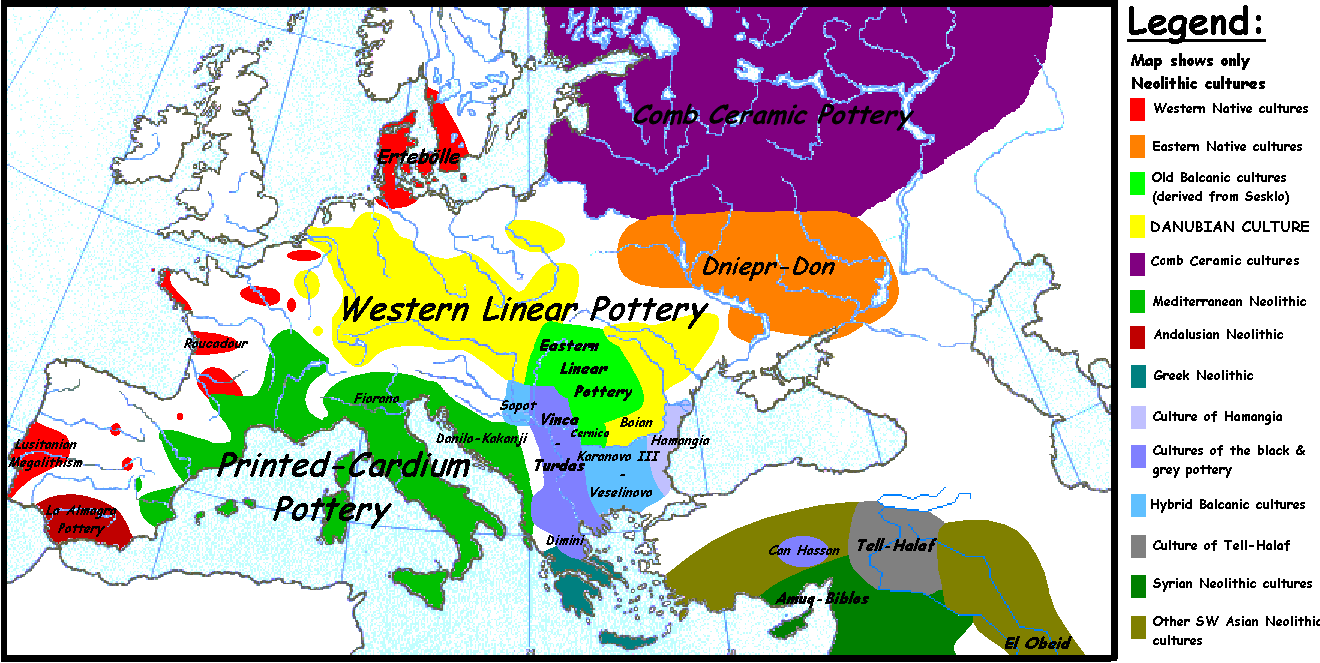
Bükk Culture
Encyclopedia

Cro-Magnon
The Cro-Magnon were the first early modern humans of the European Upper Paleolithic. The earliest known remains of Cro-Magnon-like humans are radiometrically dated to 35,000 years before present....
type people inhabiting the Bükk
Bükk
The Bükk Mountains are a section of the North Hungarian Mountains of the Inner Western Carpathians. Much of the area is included in the Bükk National Park.-Geography:...
mountains of Hungary
Hungary
Hungary , officially the Republic of Hungary , is a landlocked country in Central Europe. It is situated in the Carpathian Basin and is bordered by Slovakia to the north, Ukraine and Romania to the east, Serbia and Croatia to the south, Slovenia to the southwest and Austria to the west. The...
(inner western Carpathians) and the upper Tisza
Tisza
The Tisza or Tisa is one of the main rivers of Central Europe. It rises in Ukraine, and is formed near Rakhiv by the junction of headwaters White Tisa, whose source is in the Chornohora mountains and Black Tisa, which springs in the Gorgany range...
and its tributaries. The surrounding Neolithic
Neolithic
The Neolithic Age, Era, or Period, or New Stone Age, was a period in the development of human technology, beginning about 9500 BC in some parts of the Middle East, and later in other parts of the world. It is traditionally considered as the last part of the Stone Age...
was mainly of a more gracile Mediterranean type, with a Cro-magnon
Cro-Magnon
The Cro-Magnon were the first early modern humans of the European Upper Paleolithic. The earliest known remains of Cro-Magnon-like humans are radiometrically dated to 35,000 years before present....
admixture as another possibility. As to whether the Cro-magnons were a remnant squeezed into this pocket, there is no sign of conflict there and the Cro-magnons were doing rather well in the obsidian trade. They were, so to speak, the wealthy men of the European Neolithic.
The Cro-magnons did acquire the Neolithic from the Starčevo culture to the south. In the Szatmár culture prior to 5500 BC, the Cro-magnons modified their Mesolithic
Mesolithic
The Mesolithic is an archaeological concept used to refer to certain groups of archaeological cultures defined as falling between the Paleolithic and the Neolithic....
ways and took on Starcevan artifact types and pottery styles, and the same can be said of the succeeding Tiszadob culture of roughly 5200-5000. By 5000 the LBK had replaced the Starcevo in the surrounding region and it influenced the Cro-magnons in the Bükk culture.
Bükk pottery is the finest ware of the LBK. It has a larger variety of forms: tall stands, jars with feet, globular bowls, and so on. Their fabric is tempered with sand, as opposed to the chaff of the western LBK. The walls of the pots are thin and delicate. Decoration consists of LBK patterns composed of bands that are both painted and engraved with fine lines. Colors are white, red and yellow, just the ones to brighten and make warm a successful household. The patterns are more complex, more regular and evidence more care in their execution. Some of the patterns are probably symbols. The Cro-magnons also owned abstract human figurines, in which geometric forms represent people. These are covered with symbols.
The source of Bükk culture wealth is the fine obsidian of which the mountains are an abundant source. The Cro-magnons probably encouraged each other to settle there and take up the ethnic trade. Workshops for the manufacture of obsidian tools are common. They are identified by the hundreds of tools littering the floor of the site, which must have been a shed. These workshops were near homes. They probably represent a family business. In some cases jars of knives stand ready for export. The knives are sorted by size. An abundance of spondylus
Spondylus
Spondylus is a genus of bivalve molluscs, the only genus in the family Spondylidae. As well as being the systematic or scientific name, Spondylus is also the most often used common name for these animals, though they are also known as thorny oysters or spiny oysters.There are many species of...
shells in the graves suggests that this collectible was used for currency. Their ultimate source was the Mediterranean. These Cro-magnons, as opposed to the Mesolithics of the Atlantic coast, are probably best regarded as men of the world, dominating the market for stone tools from their mountain retreats.
The Bükk people lived a very different life from the residents of the long houses. Bükk homes are individual and rectangular, a few meters wide and about twice as long. Many are dug into the earth as wholly or partly subterranean. Others are wholly above ground, wattle and daub construction. The Bükk people sited their homes on hills, slopes, or in ravines. They used caves for sacred purposes, but may have lived there as well.
When not engaged in manufacture and trade, the Bükk people shared the same garden economy as the western variant. To the light game of the open forests they added the fierce aurochs. When death came they buried the deceased in the village, sometimes under the house. Such a custom implies a belief in spiritual continuity and lends to the family a dimension in time as well as space. In the village resided simultaneously both the living family and the spirits of their deceased.

